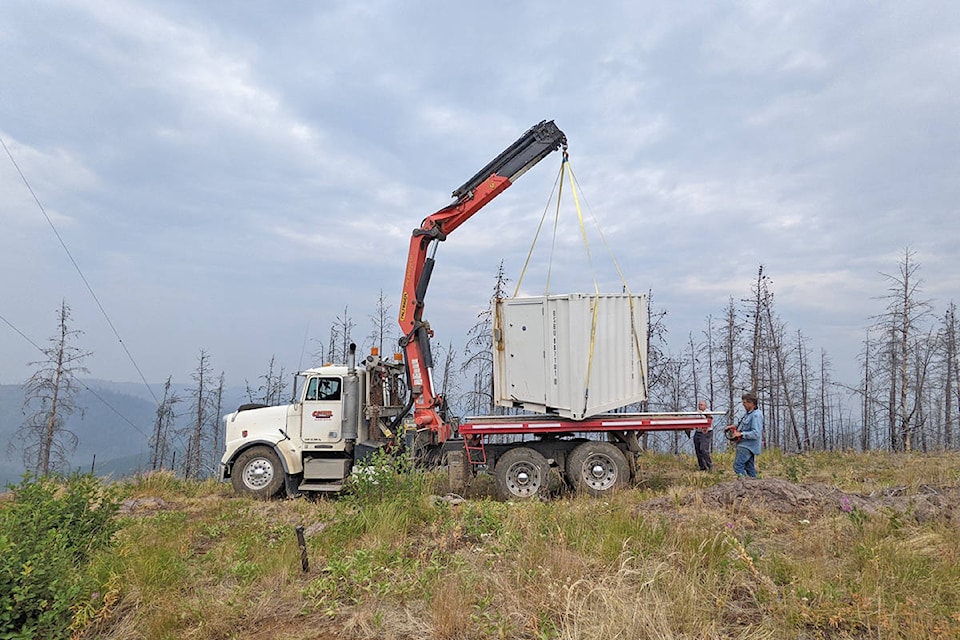Communication will be running smoothly for the Quesnel Search and Rescue (QSAR) after they teamed up with the Quesnel Amateur Radio Operators Society (QAROS) to replace a radio repeater destroyed by wildfire.
A new repeater housed in a C-can was placed on top of the remote Fishpot Mountain on Thursday, July 15, with the help of Cotter Hiab and Trucking.
It replaces a previous shed building made up of a plywood exterior which burned to the ground in 2017.
“We have nothing more of it than some melted aluminum on its former resting spot,” said Bob Holowenko, who is a member of both groups.
“So we spent the last few years trying to coordinate funding and coordinating people power to get the unit up there eventually.”
Due to poor road conditions, the organizations believed they would have to find the funding to place the shelter by helicopter — a challenge especially during wildfire season.
Read More: Baezaeko Road couple who lost everything in wildfire bolstered by donations from family
Holowenko said Cotter Hiab, however, was willing to take on the somewhat tricky task.
“That road is sketchy at best, so they were able to maneuver their equipment up there to drop our shelter off, which is a huge milestone for us,” he said.
Approximately $20,000 was raised by QSAR and QAROS for the new repeater shelter from Prince George. The shelter is solar-operated and likely to withstand any future flames.
Other radio communication infrastructure made of steel or brick for the RCMP, forestry and B.C.’s Ministry of Transportation and Infrastructure survived the 2017 blaze.
For QSAR, Holowenko said the new repeater shelter means they will have the ability to communicate with their searchers should they be tasked in the western area extending from the Bowron Lake Park Boundary to the Itcha Range.
“This gives us better repeater coverage out there,” he said.
“Obviously Nazko and area have been no stranger to natural disaster, so this gives us the ability that if we are on task out there, we are able to communicate amongst each other, vehicle to vehicle, and then vehicle back to town so that we have that extra layer of safety and communication/coordination in the event something goes sideways.”
Quesnel SAR would like to thank Cotter Hiab for taking on a tough job placing our new repeater shelter on a remote mountain top! Amazingly professional operator. This gets us closer to having a massive radio communications footprint. #Safety #SAR #BCWildfire pic.twitter.com/0nZcsuC4bv
— Quesnel Search & Rescue (@QuesnelSAR) July 16, 2021
Had QSAR been tasked before the installation of the repeater Holowenko said they would have had to put more effort and thought into how they would communicate out.
With that no longer a concern, QSAR can now focus on more operational activities in an area with no cell service past Slyvia’s Cafe.
“We’ve only got one person carrying a satellite phone, so having the ability to have communications out there now makes it significantly safer should something go wrong, and it takes a lot of the pressure off the planning and operations folks if we do have to stand up in the event of a large emergency,” Holowenko said, noting the value of knowing where everyone is and when it is time to return home or to their headquarters.
“We’ve been finding there are lots of road searches that we’ve been doing as well, and road searches are notorious for having teams spread out over a massive area,” he added.
“With a repeater, we have a much better chance of being able to communicate amongst the groups because now we have something at a high point that’s able to bridge the gap between us.”
Read More: Calls to search and rescue groups surge in B.C. as COVID-19 pushes people outdoors
Do you have a comment about this story? email:
rebecca.dyok@wltribune.com
Like us on Facebook and follow us on Twitter.
